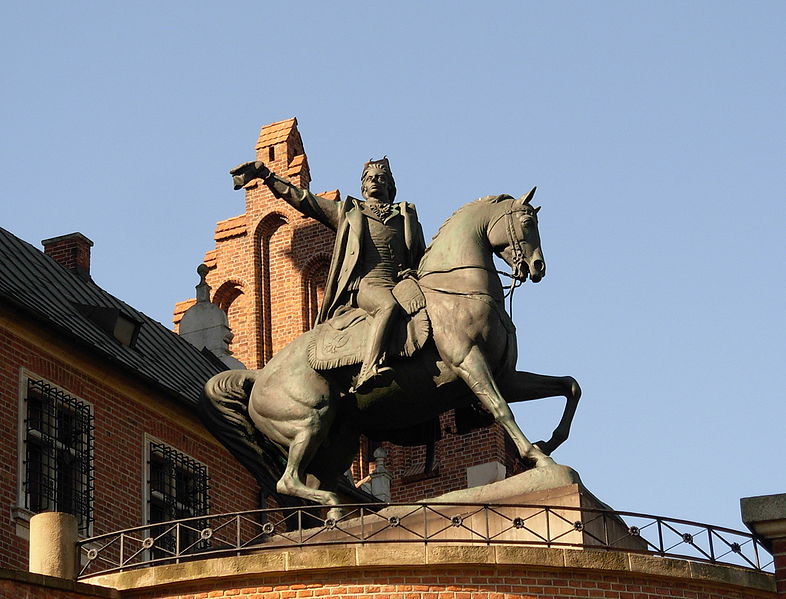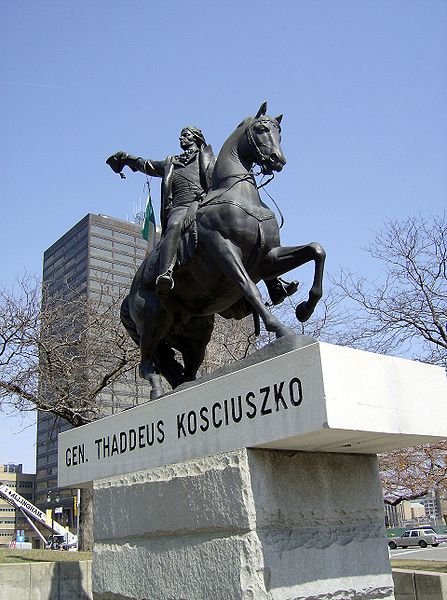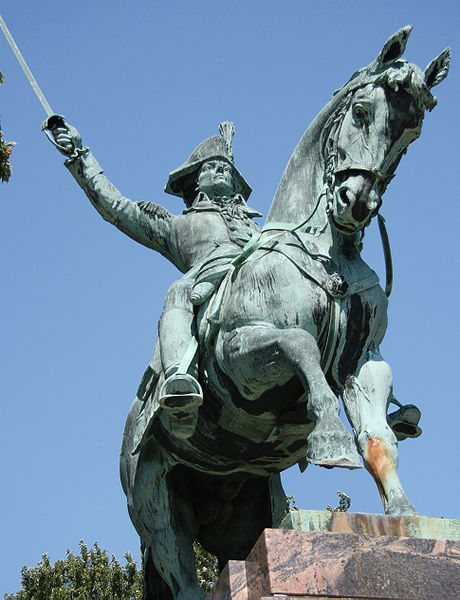<Back to Index>
- Physicist Ludwig Prandtl, 1875
- Painter Joseph Fernand Henri Léger, 1881
- General Tadeusz Kościuszko, 1746
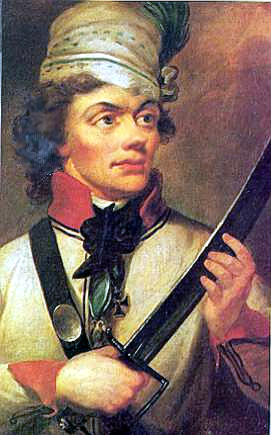
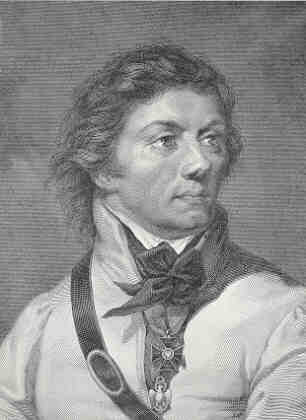
Andrzej Tadeusz Bonawentura Kościuszko (February 4, 1746 – October 15, 1817) was a Polish-Lithuanian general and military leader during the Kościuszko Uprising. He is a national hero in Poland, Lithuania, the United States and Belarus. He led the 1794 Kościuszko Uprising against Imperial Russia and Kingdom of Prussia as Supreme Commander of the National Armed Force (Najwyższy Naczelnik Siły Zbrojnej Narodowej).
Before commanding the 1794 Uprising, he had fought in the American Revolutionary War as a colonel in the Continental Army. In 1783, in recognition of his dedicated service, he had been brevetted by the Continental Congress to the rank of brigadier general and had become a naturalized citizen of the United States.
Kościuszko was born in the village of Mereczowszczyzna, now abandoned, near the present-day town of Kosava, Belarus. The area lay within the Grand Duchy of Lithuania, a part of the Polish-Lithuanian Commonwealth. He was the son of a local noble Ludwik Tadeusz Kościuszko and Tekla, née Ratomska. He was the youngest child in a family whose lineages are traced to Lithuanian and Ruthenian nobility and to a 15th–16th–century courtier of Polish King Sigismund I the Old, Konstanty Fiodorowicz Kostiuszko. At the time of Tadeusz Kościuszko's birth, the family possessed modest holdings in the Grand Duchy. His first language may have been Belarusian, and he was christened in both the Eastern Orthodox and Roman Catholic religions. As a result of the dual baptisms, he bore the names Andrei and Tadeusz. In 1765 Poland's King Stanisław August Poniatowski created at Warsaw, on the grounds of present-day Warsaw University, theSzkoła Rycerska (School of Knights) to educate military officers and government officials. Kościuszko enrolled on 18 December 1765, becoming a member of the Corps of Cadets. Upon graduation, he was promoted to captain. In
1769 Kościuszko and his colleague Orłowski were granted a royal
scholarship and on October 5 they set off for Paris. There Kościuszko
briefly studied in the Academy of Fine Arts, but soon realized that the
career of a painter was not what he dreamed of. As a foreigner he could
not apply for any of the French military academies, and he lacked the
funds to study engineering. For five years, however, Kościuszko
educated himself as an extern, frequenting lectures and the libraries
of the Paris military academies. His exposure to the Enlightenment there, coupled with the religious tolerance practiced in the Commonwealth, would have a strong influence on his later career. Kościuszko came to America on his own, and on August 30, 1776 he presented a Memorial to
Congress. He initially served as a volunteer, but on October 18, 1776,
Congress commissioned him a Colonel of Engineers in the Continental
Army. "He was assigned a black orderly named Agrippa Hull. At the recommendation of Prince Adam Kazimierz Czartoryski and General Charles Lee, Kościuszko was named head engineer of the Continental Army. He was sent to Pennsylvania to work with the Continental Army. Shortly after arriving, he read the United States Declaration of Independence.
Kościuszko was moved by the document because it encompassed everything
in which he believed; he was so moved, in fact, that he decided to meet Thomas Jefferson, the principal author of the Declaration. The two met in Virginia a
few months later. After spending the day discussing philosophy and
other things they shared in common, they became very close friends.
Kościuszko was a guest at Monticello on many occasions, and spent prolonged visits there. Kościuszko's first task in America was the fortification of Philadelphia. His first structure was the construction of Fort Billingsport. On September 24, 1776, Kościuszko was ordered to fortify the banks of the Delaware River against a possible British crossing. In the spring of 1777 he was attached to the Northern Army under Maj. Gen. Horatio Gateswhere he directed the construction of several forts and fortified military camps along the Canadian border. Subsequently posted at Fort Ticonderoga, he worked to restore the defenses of what had once been one of the most formidable fortresses in North America. His surveys of the landscape prompted him to strongly recommend the construction of a battery on Sugar Loaf Mtn. overlooking the fort. Though a prudent suggestion, and one that carried the agreement of Kościuszko's fellow engineers, garrison commander Brigadier Gen. Arthur St. Clair ultimately
declined to carry it out, citing logistical difficulties. This turned
out to be an egregious tactical blunder, as, when the British Army under General John Burgoyne arrived in July, he did exactly what Kościuszko would have done and had his engineers place artillery on the hill. With the British in
complete control of the high ground, the Americans realized their
situation was hopeless and abandoned the fortress with hardly a shot
fired in the Siege of Ticonderoga. The British advance force nipped hard on the heels of the outnumbered and exhausted Continentals as they fled southward. Maj. Gen. Philip Schuyler, desperate to put distance between his men and their pursuers, ordered scorched earth tactics along the route of retreat. In his crucial rearguard role, Kościuszko carried out these orders by directing the felling of trees, damming of streams, and destruction of all bridges and causeways to deny the British use of the roadway. Encumbered by their vast supply train, the British slowly began to bog down, giving the Americans the time needed to safely withdraw across the Hudson River. Shortly thereafter, General Gates relieved Schuyler, regrouping his forces to try and prevent the British from taking Albany.
He tapped Kościuszko to survey the countryside between the opposing
armies, choose the most defensible position he could, and fortify it.
Finding just such a position near Saratoga, overlooking the Hudson at Bemis Heights,
Kościuszko proceeded to lay out an excellent array of defenses; nearly
impregnable to attack from any direction. His excellent judgment and
meticulous attention to every detail in the American defense frustrated
the British Army attack during the final battle on October 7th, 1777. Added to the American victory at Freeman's Farm two weeks prior, the dwindling British army
was dealt a second sound tactical defeat, turning the tide of the
campaign. The Americans were then free and able to pursue and bottle up
the tattered remnants of the defeated British. Having cut off the last means of escape, Gates accepted General Burgoyne's surrender of his entire expeditionary force at Saratoga on October 16th, 1777. This complete and total American victory marked the turning point of the entire war, sealing the alliance with France on February 6th, 1778. Thereafter, Kościuszko was regarded as one of the best engineers in American service. George Washington took immediate notice, tasking him with the command of improving defensive works at the stronghold in West Point. Here he was posted until being granted his request for transfer to the Southern Army in August of 1780. Traveling southward through rural Virginia, where he witnessed chattel slavery for the first time up-close and personal, he eventually reported to his former commander Gen. Gates in North Carolina in October. However, following the disastrous defeat at the Battle of Camden on August 16th, Congress selected Washington's choice of Maj. Gen. Nathanael Greene to replace the disgraced Gates as commander of the Southern Department. When Gen. Greene formally assumed command on December 4th, 1780, Kościuszko's services were retained, employed as Greene's
chief engineer. In this capacity, he made substantial contributions
towards the planning and execution of the general's overall strategy
that culminated in the reconquest of the Carolinas & Georgia two years later. Over the course of this campaign, he was placed in charge of constructing bateaux,
siting camps, scouting river crossings, fortifying positions, and
developing intelligence contacts. Many of his contributions were
instrumental in preventing the destruction of the Southern Army. This
was especially true during the famous "Race to the Dan", where Cornwallis and his exhausted troops chased Greene through 200 miles of rough backcountry terrain in the dead of winter. Thanks largely to a combination of Greene's tactics, and Kościuszko's bateaux and accurate scouting of the rivers ahead of the main body, the Continentals safely crossed each one in its path, including the Dan River. Cornwallis, having no boats of his own, and finding no way to cross the swollen Dan, finally gave up the chase and withdrew back into North Carolina, while the Continentals regrouped south of Halifax, VA, where Kościuszko had earlier established a fortified depot at Greene's request. During the "Race to the Dan", Kościuszko had contributed to the selection of the site where Gen. Greene eventually returned to fight Cornwallis at Guilford Courthouse. Though tactically defeated, the Americans all but destroyed Cornwallis' army as an effective fighting force and gained a permanent strategic advantage in the South. Thus, as Greene began his reconquest of South Carolina in the spring of 1781, he recalled Kościuszko from Halifax to rejoin the main body of the Southern Army. It wasn't long before he was back in his engineering element at Ninety Six where, from May 22nd - June 18th, he conducted the longest siege of the Revolutionary War. Kościuszko suffered his only wound in seven full years of service during the unsuccessful siege, as he was bayonetted in his hindquarters during an assault by the Star Fort's defenders on the approach trench he was preparing. As the combined forces of the Continentals and Southern militia gradually forced the British from
the backcountry into the coastal ports during the latter half of 1781,
Kościuszko began participating in more direct action. He had already
fought in the major battles at Hobkirk's Hill (2nd Camden) in April and Eutaw Springs in September. However, he was most active throughout the final year of hostilities in much smaller actions focused on harassing British foraging parties near Charleston. His only known battlefield command of the war occurred at James Island on November 14th, 1782. In what is believed by many to be the Continental Army's
final armed action of the war, he was very nearly killed as his small
force was soundly routed. A month later, he was among the first Continental troops to reoccupy Charleston following the British evacuation
of the city. Kościuszko spent the rest of the war there, allegedly
conducting a fireworks display to celebrate news of the signing of the Treaty of Paris in April of 1783. In July 1784 Kościuszko set off for Poland, where he arrived on August 12. He settled in his home village of Siechnowicze. The property, administered by his brother-in-law, brought a small but stable income, and Kościuszko decided to limit the servitude of his peasants (corvée) to two days a week, while completely exempting female serfs. This move was seen by local szlachta (nobility) as a sign of Kościuszko's dangerous liberalism. By
that time the internal situation in Poland was changing rapidly. A
strong, if still informal, group of politicians advocated for reforms
and for strengthening the state. Notable political writers such as Stanisław Staszic and Hugo Kołłątaj argued
for granting the serfs and burghers more rights and for strengthening
the central authorities. These ideas were supported by a large part of
the szlachta, who also wanted to curb foreign meddling in Poland's internal affairs. Finally the Great Sejm of
1788–92 opened the necessary reforms. One of its first acts was to
approve the creation of a 100,000-man army to defend the Commonwealth's
borders against its aggressive neighbors. Kościuszko saw this as a
chance to return to military service and serve his country in the field
that he knew best. He applied to the army and on October 12, 1789,
received a royal commission as a major general. As such, he began receiving the high salary of 12,000 złotys a year, which ended his financial difficulties. The Commonwealth's internal situation and the reforms initiated by the Constitution of May 3, 1791,
the first constitution written in the modern era in Europe and second
in the world after the American, were seen by the surrounding powers as
a threat to their influence over Polish politics. On May 14, 1792,
conservative magnates created the Targowica Confederation, which asked Russian Tsarina Catherine II for help in overthrowing the constitution. On May 18, 1792, a 100,000-man Russian army crossed the Polish border and headed for Warsaw, thus opening the Polish-Russian War of 1792. Although
the plan to create a 100,000-man Polish Army was not accomplished due
to economic problems, the Polish Army was well-trained and prepared for
war. Before the Russians invaded Poland, Kościuszko was appointed deputy commander of Prince Józef Poniatowski's 3rd Crown Infantry Division. When the Prince became Commander in Chief of the entire Polish Army on May 3, 1792, Kościuszko automatically assumed command of the Division. After Prussia's
betrayal of her Polish ally, the Army of Lithuania did not oppose the
advancing Russians. The Polish Army was too weak to oppose the enemy
advancing into Ukraine and withdrew to the western side of the Bug River, where it regrouped and counterattacked. Victorious in the Battle of Zieleńce (June 18, 1792), Kościuszko was among the first to receive the newly-created Virtuti Militari medal, Poland's highest military decoration even today. In the ensuing Battles of Włodzimierz (July 17, 1792) and Dubienka (July 18) Kościuszko repulsed the numerically superior enemy and came to be regarded as one of Poland's most brilliant military commanders of the time. On August 1, 1792, King Stanisław August promoted him to Lieutenant General. But before the nomination arrived at Kościuszko's camp in Sieciechów, the King had joined the ranks of the Targowica Confederation and surrendered to the Russians. The
King's capitulation was a hard blow for Kościuszko, who had not lost a
single battle in the campaign. Together with many other notable Polish
commanders and politicians he fled to Dresden and then to Leipzig, where the émigrées began preparing an uprising against Russian rule in Poland. The politicians, grouped around Ignacy Potocki and Hugo Kołłątaj,
sought contacts with similar opposition groups formed in Poland and by
spring 1793 had been joined by other politicians and revolutionaries,
including Ignacy Działyński. On August 26, 1792, the French Legislative Assembly awarded Kościuszko with honorary citizenship of France in
honor of his fight for freedom of his fatherland and the ideas of
equality and liberty. After two weeks in Leipzig, Kościuszko set off
for Paris, where he tried to gain French support of the planned
uprising in Poland. On January 13, 1793, Prussia and Russia signed the Second Partition of Poland, which was ratified by the Sejm of Grodno on June 17. Such an outcome was a giant blow for the members of Targowica Confederation who saw their actions as a defense of centuries-old privileges of the magnates, but now were regarded by the majority of the Polish population as traitors. After the partition Poland became a small country of roughly 200,000 square kilometres and
a population of approximately 4 million. The economy was ruined and the
support for the cause of an uprising grew significantly, especially
since there was no serious opposition to the idea after the Targowica
Confederation was discredited. In
June of 1793 Kościuszko prepared a plan of an all-national uprising,
mobilization of all the forces and a war against Russia. The
preparations in Poland were slow and he decided to postpone the
outbreak. However, the situation in Poland was changing rapidly. The
Russian and Prussian governments forced Poland to again disband the
majority of her armed forces and the reduced units were to be drafted
to the Russian army. Also, in March the tsarist agents discovered the
group of revolutionaries in Warsaw and started arresting notable Polish
politicians and military commanders. Kościuszko was forced to execute
his plan earlier than planned and on March 15, 1794 he set off for Kraków. In 1796 Tsar Paul I of Russia pardoned
Kościuszko and set him free. In exchange for his oath of loyalty, Paul
I also freed some 20,000 Polish political prisoners held in Russian
prisons and forcibly settled in Siberia.
The Tsar granted Kościuszko 12,000 roubles, which the Polish leader
attempted in 1798 to return; the Tsar refused to accept it back as
"money from a traitor". During the Uprising, Kościuszko was made Naczelnik (Commander-in-Chief) of all Polish-Lithuanian forces fighting against Russian occupation, and issued the famous Proclamation of Połaniec. After initial successes following the Battle of Racławice, he was wounded in the Battle of Maciejowice and taken prisoner by the Russians, who imprisoned him in Saint Petersburg—Kościuszko was held at Prince Orlov's Marble Palace. The uprising ended soon afterwards with the Siege of Warsaw. Kościuszko emigrated to the United States, but the following year returned to Europe and in 1798 settled in Breville, near Paris. Still devoted to the Polish cause, he took part in creating the Polish Legions. Also, on October 17 and November 6, 1799 he met with Napoleon Bonaparte.
However, he failed to reach any agreement with the French leader, who
regarded Kościuszko as a "fool" who "overestimated his influence" in
Poland (letter from Napoleon to Fouché, 1807).
Kościuszko remained politically active in Polish émigré
circles in France and in 1799 was a founding member of the Society of Polish Republicans. However, he did not return to the Duchy of Warsaw and did not join the reborn Polish Army allied with Napoleon. Instead, after the fall of Napoleon's empire in 1815 he met with Russia's Tsar Alexander I in Braunau.
In return for his prospective services, Kościuszko demanded social
reforms and territorial gains for Poland, which he wished to reach as
far as the Dvina and Dnieper Rivers in the east. Alexander asked him to go to Warsaw. However, soon afterwards, in Vienna, Kościuszko learned that the Kingdom of Poland created by the Tsar would be even smaller than the earlier Duchy of Warsaw. Kościuszko called such an entity "a joke"; and when he received no reply to his letters to the Tsar, he left Vienna and moved to Solothurn, Switzerland,
where his friend Franciszek Zeltner was mayor. Suffering from poor
health and old wounds, on October 15 1817 Kościuszko died there of
typhoid fever. Two years earlier, he had emancipated his serfs.
By the First Partition of the Polish-Lithuanian Commonwealth, in 1772, the adjoining countries of Russia, Prussia and
Austria annexed large swaths of Polish-Lithuanian territory and
acquired influence over the internal politics of the reduced Poland and
Lithuania. The Polish-Lithuanian Commonwealth was forced to cut back its Army to
10,000 men, and when Kościuszko finally returned home in 1774, there
was no place for him in the Army. He took a position as tutor in the
family of a provincial governor and fell in love with his pupil Ludwika
Sosnowska. They eloped but were overtaken by her father's retainers. In autumn of 1775 he decided to emigrate.
In late 1775 Kościuszko arrived in Dresden, where he wanted to join either the Saxon court or the Elector's army. However, he was refused and decided to travel back to Paris. There he was informed of the outbreak of the American Revolutionary War,
in which the British colonies in North America had revolted against the
crown and begun their struggle for independence.
After seven years of faithful and uninterrupted service to the American cause, on October 13, 1783, Kościuszko was promoted by Congress to the rank of brigadier general. He also received American citizenship, a grant of land near present day Columbus, OH, and was admitted to both the prestigious Society of the Cincinnati and the American Philosophical Society. When he was leaving America, he wrote a last will, naming Thomas Jefferson the
executor and leaving his property in America to be used to buy the
freedom of black slaves, including Jefferson's, and to educate them for
independent life and work. Several years after Kosciuszko's death, Jefferson pled an inability to act as executor, an action deprecated by the abolitionist William Lloyd Garrison and Jefferson historian Merrill Peterson. The U.S. Supreme Court awarded the estate to Kosciuszko's descendants in 1852, ruling that he had died intestate despite the four wills he had made. During
the legal proceedings between the date of his death and the Supreme
Court decision, the value of his estate decreased substantially; this
was attributed by a case attorney to Colonel George Bomford's use of the estate for his own purposes. None of the monies that Kościuszko had earmarked for the manumission and education of African-Americans were ever used for that purpose.
